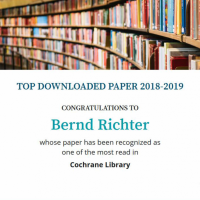
Our review "Development of type 2 diabetes mellitus in people with intermediate hyperglycaemia" (authors: Bernd Richter, Bianca Hemmingsen, Maria-Inti Metzendorf, Yemisi Takwoingi) belongs to the top 10% most downloaded Cochrane Reviews of the years 2018/19. It is one of the first Cochrane reviews focussing on a prognostic question and includes evidence from 103 prospective cohort studies.
Background
Intermediate hyperglycaemia is characterised by one or more measurements of elevated blood glucose concentrations, such as impaired fasting glucose, impaired glucose tolerance and elevated glycosylated haemoglobin A1c (HbA1c). These levels are higher than normal but below the diagnostic threshold for type 2 diabetes mellitus. The reduced threshold of 5.6 mmol/L (100 mg/dL) fasting plasma glucose for defining IFG, introduced by the American Diabetes Association in 2003, substantially increased the prevalence of impaired fasting glucose. Likewise, the lowering of the HbA1c threshold from 6.0% to 5.7% by the American Diabetes Association in 2010 could potentially have significant medical, public health and socioeconomic impacts.
Objectives
To assess the overall prognosis of people with intermediate hyperglycaemia for developing type 2 diabetes mellitus, regression from intermediate hyperglycaemia to normoglycaemia and the difference in T2DM incidence in people with IH versus people with normoglycaemia.
Authors' conclusions
Overall prognosis of people with intermediate hyperglycaemia worsened over time. Type 2 diabetes mellitus cumulative incidence generally increased over the course of follow‐up but varied with IH definition. Regression from intermediate hyperglycaemia to normoglycaemia decreased over time but was observed even after 11 years of follow‐up. The risk of developing type 2 diabetes mellitus when comparing intermediate hyperglycaemia with normoglycaemia at baseline varied by IH definition. Taking into consideration the uncertainty of the available evidence, as well as the fluctuating stages of normoglycaemia, IH and T2DM, which may transition from one stage to another in both directions even after years of follow‐up, practitioners should be careful about the potential implications of any active intervention for people 'diagnosed' with intermediate hyperglycaemia.
